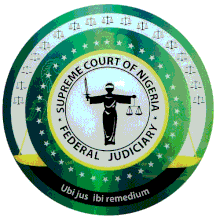Supreme Court of Nigeria
The Supreme Court of Nigeria (SCN), is the highest court in Nigeria, and is located in the Central District, Abuja, in what is known as the Three Arms Zone, so called due to the proximity of the offices of the Presidential Complex, the National Assembly, and the Supreme Court.[1][2]
| Supreme Court of Nigeria | |
|---|---|
 | |
| Established | October 1, 1963 |
| Location | Three Arms Zone, Abuja, FCT, Nigeria |
| Composition method | Presidential nomination with Senate confirmation |
| Authorized by | Constitution of Nigeria |
| Judge term length | Life tenure with mandatory retirement at the age of 70. |
| Number of positions | 16 |
| Website | www |
| Chief Justice of Nigeria | |
| Currently | Ibrahim Tanko Muhammad |
 |
|---|
| This article is part of a series on the politics and government of Nigeria |
|
Judiciary |
|
|
|
Overview
In 1963, the Federal Republic of Nigeria was proclaimed and Nnamdi Azikiwe became its first President. Appeals from the Federal Supreme Court to the Judicial Committee of the Privy Council were abolished at that point, and the Supreme Court became the highest court in Nigeria. In 1976, the Court of Appeal (originally known as the Federal Court of Appeal) was established as a national court to entertain appeals from the High Courts of each of Nigeria's 36 states, which are the trial courts of general jurisdiction. The Supreme Court in its current form was shaped by the Supreme Court Act of 1990 and by Chapter VII of the 1999 Constitution of Nigeria.
Under the 1999 constitution, the Supreme Court has both original and appellate jurisdictions, has the sole authority and jurisdiction to entertain appeals from Court of Appeal, having appellate jurisdiction over all lower federal courts and highest state courts. Decisions rendered by the court are binding on all courts in Nigeria except the Supreme Court itself.
Structure and organization
The Supreme Court is composed of the Chief Justice of Nigeria and such number of justices not more than 21, appointed by the President on the recommendation of the National Judicial Council, (NJC)[3][4] and subject to confirmation by the Senate. Justices of the Supreme Court must be qualified to practice law in Nigeria, and must have been so qualified for a period not less than fifteen years. Justices of the Supreme Court of Nigeria have a mandatory retirement age of 70 years.[5][6]
Current justices
| Office | Name | Term |
| Chief Justice (acting) | Ibrahim Tanko Muhammad | 2006–incumbent |
| Associate Justice | Bode Rhodes-Vivour | 2010–incumbent |
| Associate Justice | Nwali Sylvester Ngwuta | 2011–incumbent |
| Associate Justice | Mary Odili | 2011–incumbent |
| Associate Justice | Olukayode Ariwoola | 2011–incumbent |
| Associate Justice | Musa Datijo Muhammad | 2012–incumbent |
| Associate Justice | Kumai Bayang Akaahs | 2012–incumbent |
| Associate Justice | Kudirat Kekere-Ekun | 2013–incumbent |
| Associate Justice | John Inyang Okoro | 2013–incumbent |
| Associate Justice | Chima Centus Nweze | 2014–incumbent |
| Associate Justice | Amiru Sanusi | 2015–incumbent |
| Associate Justice | Amina Adamu Augie | 2016–incumbent |
| Associate Justice | Ejembi Eko | 2016–incumbent |
| Associate Justice | Paul Adamu Galinje | 2016–incumbent |
| Associate Justice | Sidi Dauda Bage | 2016–incumbent |
| Associate justice | Uwani Musa Abba Aji | 2018-incumbent |
Updated list
| 1 | Hon. Justice Walter S. N. Onnoghen GCON |
| 2 | Hon. Justice Ibrahim Tanko Muhammad CFR |
| 3 | Hon. Justice Olabode Rhodes-Vivour CFR |
| 4 | Hon. Justice Nwali Sylvester Ngwuta CFR |
| 5 | Hon. Justice Mary Ukaego Peter-Odili CFR |
| 6 | Hon. Justice Olukayode Ariwoola |
| 7 | Hon. Justice Musa Dattijo Muhammad |
| 8 | Hon. Justice Kumai Bayang Akaahs OFR |
| 9 | Hon. Justice Kudirat Motonmori Olatokunbo Kekere-Ekun |
| 10 | Hon. Justice John Inyang Okoro |
| 11 | Hon. Justice Chima Centus Nweze |
| 12 | Hon. Justice Amiru Sanusi OFR |
| 13 | Hon. Justice Amina Adamu Augie CON |
| 14 | Hon. Justice Ejembi Eko |
| 15 | Hon. Justice Paul Adamu Galinje |
| 16 | Hon. Justice Sidi Dauda Bage |
| 17 | Hon. Justice Uwani Abba Aji |
Justice Sidi Dauda Bage was appointed Emir of Lafia
See also
References
- siteadmin (2019-07-18). "Steer Clear Of Three Arms Zone, Police Warn Nigerian Protesters". Sahara Reporters. Retrieved 2020-02-17.
- Shuaibu, Umar (2014-05-05). "The desecration of the Three Arms Zone". Daily Trust. Retrieved 2020-02-17.
- "NJC approves appointment of four Supreme Court Justices - Premium Times Nigeria". 2019-10-24. Retrieved 2020-02-17.
- "NJC approves 4 Supreme Court Justices' appointment | P.M. News". pmnewsnigeria.com. Retrieved 2020-02-17.
- "Recruitment and Tenure of Supreme Court Justices in Nigeria".
- "Constitution of the Federal Republic of Nigeria". www.nigeria-law.org.